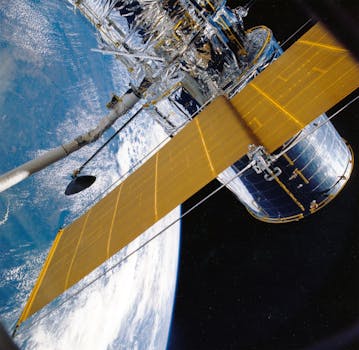Satellite Telecommunications 2023: What’s New and What’s Next? – Satellite Telecommunications

Satellite Telecommunications 2023: What’s New and What’s Next? Satellite telecommunications play a vital role in our daily lives, from enabling global communication to providing critical services such as navigation, weather forecasting, and remote sensing. The world of satellite telecommunications is rapidly evolving, with new technologies and innovations emerging every year. In 2023, we can expect significant advancements in satellite communications, from improved connectivity to enhanced security.
The launch of new satellite constellations, such as SpaceX’s Starlink and Amazon’s Kuiper Systems, is expected to increase global connectivity, particularly in remote and underserved areas. These constellations will provide high-speed, low-latency internet services, enabling more people to access the digital world. Additionally, the development of new satellite technologies, such as phased array antennas and advanced propulsion systems, will improve the efficiency and effectiveness of satellite communications.
In the field of satellite telecommunications, security is a top priority. As the number of satellites in orbit increases, so does the risk of cyber threats and space debris. To address these concerns, satellite operators and manufacturers are investing in advanced security measures, such as encryption and intrusion detection systems. Moreover, international cooperation and regulatory frameworks are being established to ensure the long-term sustainability of space activities.
The use of satellite telecommunications is not limited to commercial applications. Governments and military agencies also rely on satellite communications for critical operations, such as command and control, surveillance, and reconnaissance. In 2023, we can expect to see advancements in satellite-based communications for military and government applications, including the development of more secure and resilient satellite systems.
In conclusion, the world of satellite telecommunications is poised for significant growth and innovation in 2023. With the launch of new satellite constellations, advancements in satellite technologies, and a focus on security and sustainability, the future of satellite communications looks bright. As the demand for satellite telecommunications continues to increase, we can expect to see new opportunities emerge for industries, governments, and individuals alike.
One of the key trends in satellite telecommunications is the increasing use of small satellites, also known as smallsats. Smallsats are smaller, lighter, and less expensive than traditional satellites, making them an attractive option for a wide range of applications, from Earth observation to communication. In 2023, we can expect to see a significant increase in the number of smallsats launched into orbit, as companies and governments look to take advantage of their flexibility and cost-effectiveness.
Another trend in satellite telecommunications is the growing importance of satellite-based broadband services. With the increasing demand for high-speed internet services, satellite-based broadband is becoming an essential part of the global telecommunications landscape. In 2023, we can expect to see significant advancements in satellite-based broadband services, including the launch of new satellite constellations and the development of more advanced technologies, such as beamforming and frequency reuse.
The use of artificial intelligence (AI) and machine learning (ML) is also becoming more prevalent in satellite telecommunications. AI and ML can be used to improve the efficiency and effectiveness of satellite communications, from predicting and preventing outages to optimizing network performance. In 2023, we can expect to see a growing number of satellite operators and manufacturers investing in AI and ML technologies, as they look to stay ahead of the curve in the rapidly evolving satellite telecommunications market.
Finally, the issue of space debris is becoming a major concern in the satellite telecommunications industry. As the number of satellites in orbit increases, so does the risk of collisions and the accumulation of space debris. In 2023, we can expect to see a growing focus on sustainable space practices, including the development of new technologies and regulatory frameworks to mitigate the risks associated with space debris.
In the section of satellite telecommunications, there are many companies and organizations working together to improve the industry. For example, the Satellite Industry Association (SIA) is a trade association that represents the satellite industry and works to promote the interests of its members. The SIA provides a forum for satellite operators, manufacturers, and service providers to come together and discuss the latest trends and innovations in the industry.
The International Telecommunication Union (ITU) is another important organization in the satellite telecommunications industry. The ITU is a specialized agency of the United Nations that plays a critical role in coordinating the development of global telecommunications networks, including satellite communications. The ITU provides a framework for countries to work together to establish common standards and regulations for satellite communications, which helps to ensure the smooth operation of global telecommunications networks.
In the field of satellite telecommunications, there are many different types of satellites, each with its own unique characteristics and applications. For example, geostationary satellites are used for telecommunications, broadcasting, and weather forecasting, while polar-orbiting satellites are used for Earth observation and remote sensing. Low-Earth orbit satellites are used for a variety of applications, including communication, navigation, and scientific research.
The development of new satellite technologies is a critical aspect of the satellite telecommunications industry. Companies and governments are investing heavily in research and development to improve the efficiency, effectiveness, and sustainability of satellite communications. Some of the key areas of focus include the development of new propulsion systems, advanced materials, and more efficient power sources.
In conclusion, the satellite telecommunications industry is a complex and rapidly evolving field, with many different companies, organizations, and technologies working together to provide critical services to people around the world. As the demand for satellite communications continues to grow, we can expect to see new innovations and advancements emerge in the years to come.





